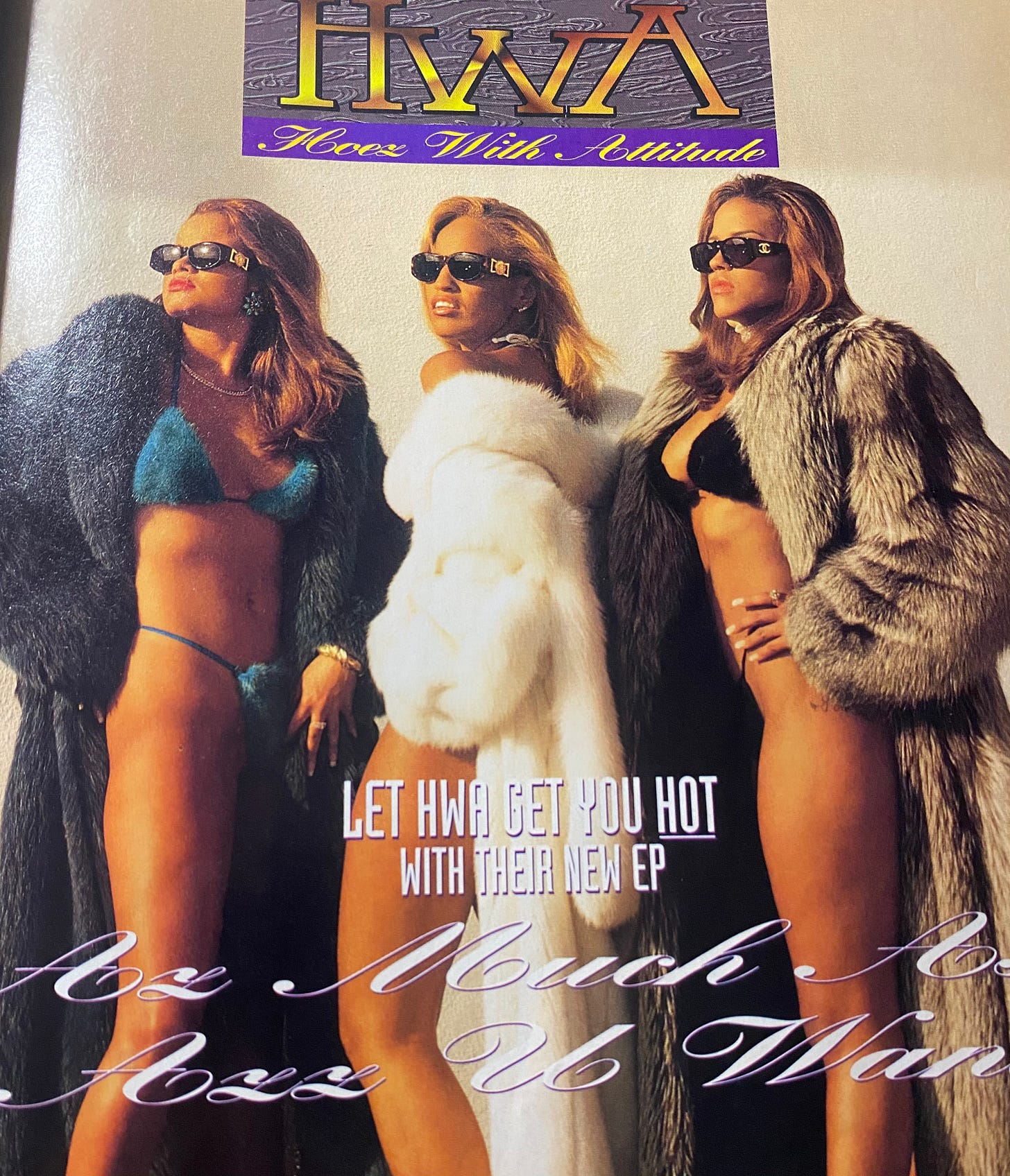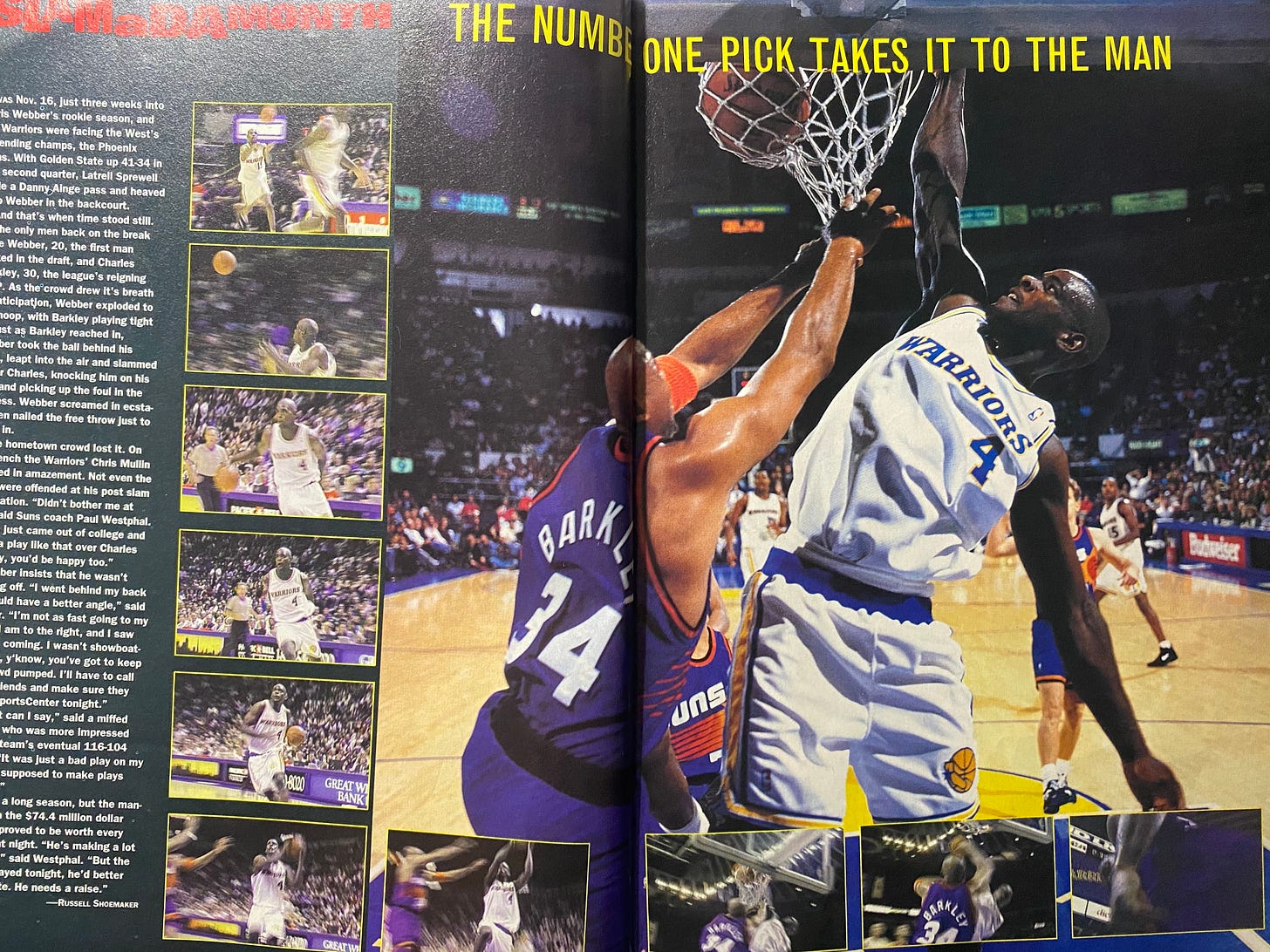Bonus Cut: Inside SLAM's first issue
SLAM's original mission statement, Reggie Miller, The NBA All-White Team, and more. Also: Scoop Jackson's favorite magazine covers.
Hi everyone. Welcome to my newsletter companion to “Cover Story,” a basketball book I wrote which is set for release on October 19th and is available for pre-order here. If you want to tell your followers about my book, feel free to share this tweet or this Instagram post. If you’re not a newsletter subscriber, click here to make sure you get every post in your inbox.
One of my favorite hobbies growing up in Hong Kong was reading manga (basically comic books and graphic novels originating from Japan). “Dragon Ball Z” was my favorite, but “Doraemon,” “Crayon Shin-chan,” and “Captain Tsubasa” were close behind. Whenever we went out for dim sum with my parents and our extended family, I would pester my mom until she would go to the newsstand outside of the restaurant and buy me something new to read.
I discovered a basketball manga named "Slam Dunk” (It still bothers me to this day that a lot of North American basketball fans have never read “Slam Dunk.” I wrote a feature about it a few years ago which you can read here) before my family immigrated from Hong Kong to Canada in 1992. I knew about The Dream Team and Air Jordan sneakers, but this manga series was my gateway drug into basketball.
I moved to Canada and started learning about new sports like hockey (For the longest time, I thought ‘stay-at-home defenceman’ meant the player only played home games and never traveled on the road) and baseball (I was so confused when pitchers would bat in certain games, but not others). But my favorite sport was basketball. Two things helped me fall in love with the sport: The Raptors coming to Toronto and a magazine named SLAM.
Owning and reading an issue of SLAM was cool. It felt like a publication run by people you wanted to hang out with. They would tell you about players you had never heard about and talk about basketball in a way you had never read about in a sports magazine before. You were invited to a community and granted access to a place that no one around you were privy to.
The second section of “Cover Story” is about the beginning of SLAM and the stories behind their most iconic covers. One of the chapters is a behind-the-scenes look at the making of SLAM’s very first issue with commentary from Dennis Page, the magazine’s founder and publisher, and their first editor-in-chief Cory Johnson. We’ll save those details for the book (which you should absolutely pre-order here if you haven’t! Great job organically promoting your book in this newsletter, Alex) and instead take a look inside SLAM’s first issue today.
Before we get started, I am giving away a copy of SLAM’s first issue and you have to do is email me and tell me about your favorite magazine cover (I’m encouraging people to pick something other than Sports Illustrated and SLAM since we’re going to talk about them a lot and it doesn’t have to be sports). I’ve started a thread with some of your favorite covers here and will be updating it regularly. Hit me up and tell me about your favorite covers! I’ll announce the winner to the giveaway in next Friday’s post.

We aim to present a magazine about and for basketball fans and players.
This one sentence stands out from Cory Johnson’s letter from the editor in the very first issue. SLAM wasn’t just telling their audience what they wanted to be. They were telling them what they didn’t want to be. Today, Johnson remembers a six-page pamphlet that was put together to pitch the magazine idea to advertisers before the first issue hit newsstands. It featured Shawn Kemp of the Seattle Supersonics on the cover. “We very intentionally did not put Michael Jordan on the cover of our brochure,” Johnson told me. “We wanted to say: Sports Illustrated is just about Michael. We’re about the game of basketball.”

It would take some time before advertisers and even (some) players understood the appeal of SLAM.
A magazine that wrote in a fan’s voice and asked players about what they were listening to before games sounds like a pretty obvious idea today. It was a completely new and daring idea for a basketball publication in 1994.
A new generation of players and fans who grew up immersed in the culture of hip-hop would embrace the magazine, but many of the older players never got it. When SLAM surveyed players around the league for their favorite music artists in the first issue (The legendary Pooh Richardson selected Hall & Oates), Reggie Miller (who would become SLAM’s biggest rival in the early years) blew off the magazine completely.
SLAM is fundamentally the same in its approach today almost 30 years after their debut issue.
The first issue is also an Easter Egg treasure trove including a 16-year-old Paul Pierce cameo and a byline from Nancy Jo Sales, who went on to write the 2010 Vanity Fair article “The Suspects Wore Louboutins,” which was adapted into the 2013 satirical crime film “The Bling Ring” directed by Sofia Coppola.
SLAM covered everything from streetball to high school to college to the pros while also highlighting the cultural aspects of the game, including the growing industry of basketball sneakers. It wouldn’t just celebrate the stars, it would celebrate the game of basketball. It was a genius way to foster a connection with diehard basketball fans.
There is a notable absence on the masthead flipping through the pages of the first issue.
Scoop Jackson did not make his debut until the third issue. If you grew up reading the magazine like me, then you know he was the voice of SLAM and the voice of basketball for an entire generation of fans.
I had several wonderful conversations with Scoop for “Cover Story.” One of the things I learned was the origin story of his nickname.
On Friday, November 22, 1963, president John F. Kennedy was shot and killed while traveling in a motorcade through downtown Dallas. The following day, Robert “Scoop” Jackson was born. Scoop’s father was a Chicago-based newspaper reporter, and one of the family members joked how the birth of his son was going to scoop the assassination of JFK. A nickname was born. He was called Scoopy growing up. One of his cousins calls him Bob.
But does anyone refer to Scoop by his birth name?
“Just bill collectors,” he told me.
We also talked about his childhood years, why he didn’t get into sportswriting before SLAM, the time he went to the Georgetown campus and knocked on Allen Iverson’s door, what Kevin Garnett and Ronnie Fields brought to the city of Chicago where he grew up, the idea of a masthead comprised of primarily white people putting together a magazine about Black athletes, and more. You can read about it in “Cover Story.”
I reached out to Scoop recently and asked him to pick his three favorite magazine covers with one caveat: he wasn’t allowed to pick any SLAM covers.
Here were his picks:

“The audacity—especially at the time —to even compare and associate Muhammad Ali to a Christian saint (Saint Sebastian) was dystopian and incomprehensible… at best. So when Carl Fischer (photographer) and George Lois (art director) did it anyway, and placed the concept and brilliantly executed image of that concept on the cover of Esquire at a time when Ali was the most despised and feared American in America, it not only became one of the supremely transformative moments in magazine publishing history, but it transformed Ali into the one thing white America never wanted him to ever become: a living martyr.”

“Before the premiere issue dropped, when the magazine was titled Volume, there was a meeting on the 34th floor of the Time-Warner Building with a room full of white editorial executives who green-lit publications and covers with the belief that “covers with black faces didn’t sell.” (Editor’s note: This specific story is referencing is part of this oral history of Vibe by Dan Charnas). Then, with the power of Quincy Jones, the “test issue” of Vibe hit the stands with the darkest, most-deliberately black and beautiful image of Treach, in full NBN “ghetto bastard/PE logo” mode (shirtless, block braids, tats, arms crossed, don’t-fuck-with-us-ever facial expression, etc.) starring directly at America introducing himself, our culture, our people and this magazine to a world full of “thems” who were conditioned to never really see us in the first place.”

“It takes a whole hella lot for legendary artist Kadir Nelson to exceed his own genius (especially when it comes to his list of covers for The New Yorker over the years), but the one he delivered for this issue ascends above damn anything he’s ever done. As black creators and activists in this current moment of reckoning, we’ve all tried to create singular pieces of power that spoke both to and for us, our past and present. Something that explained the pain, the screams, the fatigue, the fight, and why us just “mattering” in this country is never enough. Kadir, as he often does, did that without having to say a single word.”
I’ll be back on Tuesday to talk about Ego Trip’s Book of Rap Lists and Jeff Weiss’s favorite covers.
Thanks for reading the newsletter. Feel free to subscribe if it’s your first time reading. You can pre-order “Cover Story” here and find me on Twitter and Instagram. Email me if you want to chat.










